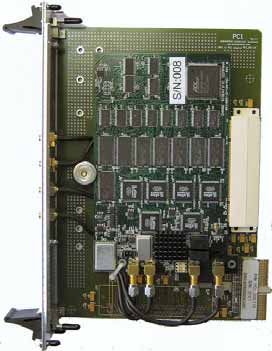

6U;CPCI总线 ;1.0 GHz采样, 12位任意波形发生器

产品简介: 6U;CPCI总线 ;1.0 GHz/s采样, 12位单通道任意波形发生器卡,4MB标配内存,可升级16MB 内存。
6U;CPCI总线 ;1.0 GHz采样, 12位任意波形发生器卡
●1GHz任意波形发生器
●1通道数据同时产生
●CS11000:4MB 板载内存
● 可扩展到16M 板载内存
●12Bit垂直分辨率
●每秒10亿次转换
●模拟输出带宽大于300MHz
●输出频率500MHz到250Hz
●输出电压范围± 250mV
●输出耦合AC
●输出精度±3%
●波形产生方式、自由运行方式(连续循环)、触发方式(单次)
●免费的任意波形发生应用软件
●二次开发工具C/C++ 和LABVIEW
• 1.0 GS/s, 12-bit vertical resolution
• 6U cPCI compliant card
• 1 Output channel, SMA connector
• SFDR less than -50 dB at 250 MHz
• Full scale Trise/Tfall = 370 psec typical
• Program up to 32K independent segments
• Program up to 16K loops/segment
• 4 MS memory standard (up to 16M in option)
• 1 TTL marker output standard
• Synchronous trigger input
• External Clock I/O
• Programmable attenuator card (option 3)
• Software Drivers for Windows 95, 98,
NT,2000, XP, and Linux (option 5).
The DA11000c is the fastest cPCI based Arbitrary
Waveform Generator in the world. The DA11000
incorporates advanced features such as programmable
segment sizes, up to 32K programmable
segments, and programmable loop counts from 1 -
64K plus continuous. 4 MS of memory standard is
available The standard cPCI architecture provides
orders of magnitude faster data transfer rates than
GPIB or serial ports.
Most Features Built-In
The DA11000c has the most popular features already
built in. The DA11000 includes 4MEG memory
and full segmentation control.
Memory
The DA11000c comes standard with 4 MW of sample
memory on-board (up to 16 MW in option).
Memory is accessed automatically when the user
manipulates the data segments (user arrays) via
the software drivers. Also, by allowing each segment
the ability to loop independently, the effective
amount of memory is many times the physical
memory.
Software Drivers, User Interface
A universal DLL is available for Windows 95/98/
NT/2000 /XP. LabVIEW driver is also available.
Linux has grown in popularity and Acquitek has
committed to this open platform. A simple debug
Graphical User Interface (GUI) software is
included with the drivers. Call Acquitek for drivers
for other operating systems.
Ideal for Embedded Systems
The DA11000 is ideal for embedded applications
where a bench-top instrument simply won’t fit
the space desired or will bust the budget for the
project. It provides OEMs and system builders a
way to develop smaller, more efficient (faster
transfer rates), and less expensive solutions
than any bench-top or tethered products using
GPIB.
• Radar design and testing
• Optical and Magnetic Storage Testing
• Advanced Ultrasound Design
• Video design, test, and production
• Network analysis
• Communications
• RF signal generation
010-62156134 62169728 13301007825 节假日:13901042484 微信号:sun62169728
地址:北京市西城阜外百万庄扣钟北里7号公寓
E_mail:sales@pc17.com.cn 传真: 010-68328400
京ICP备17023194号-1 公备110108007750




 售价:¥79000
售价:¥79000